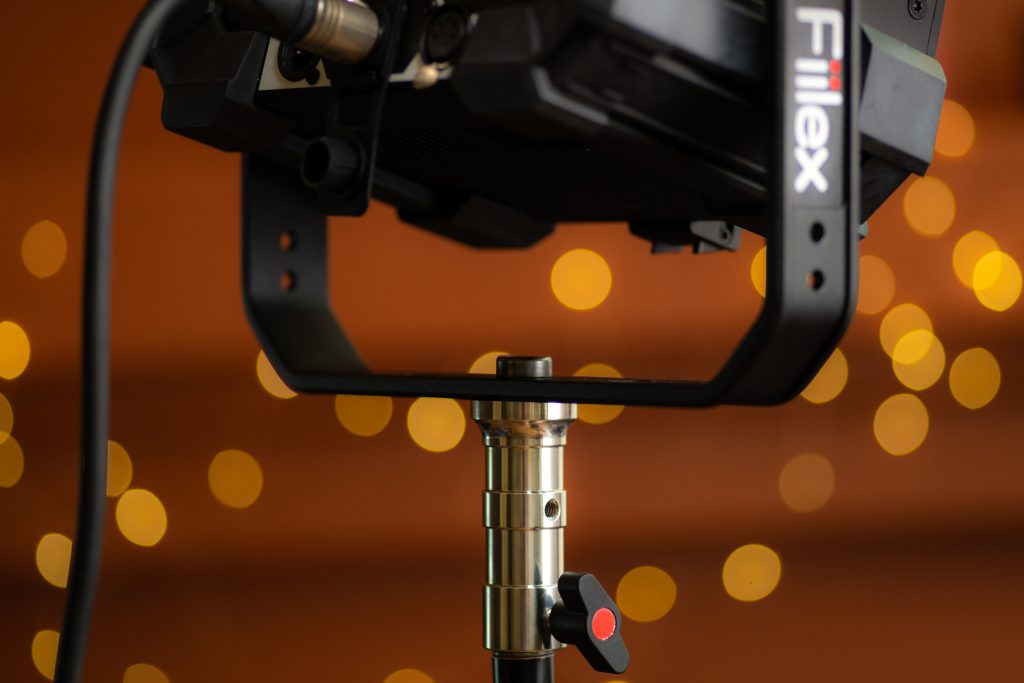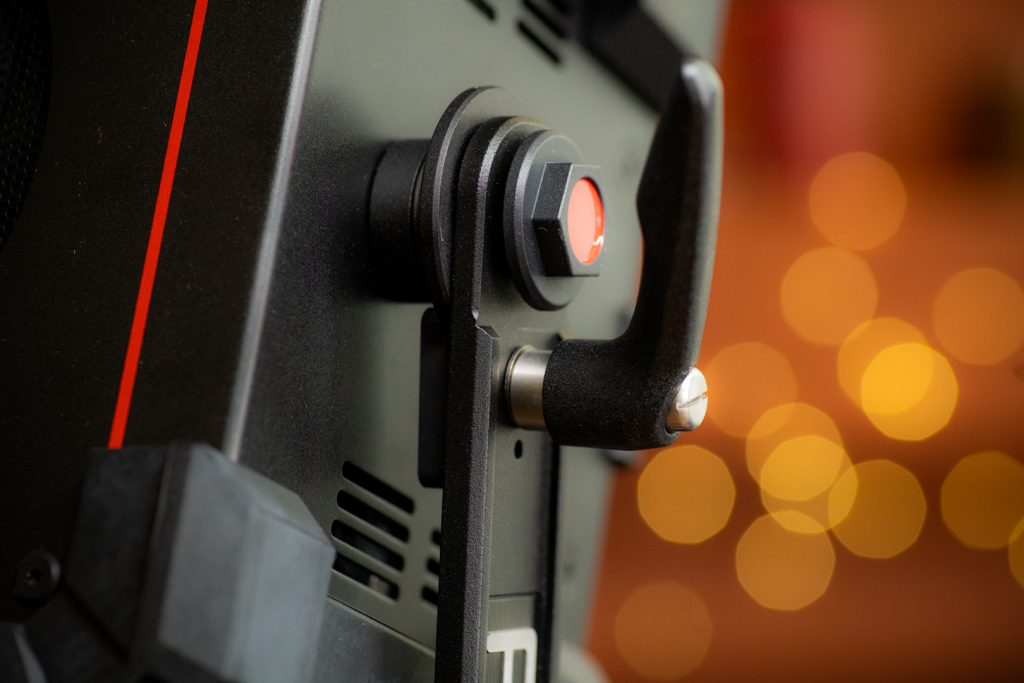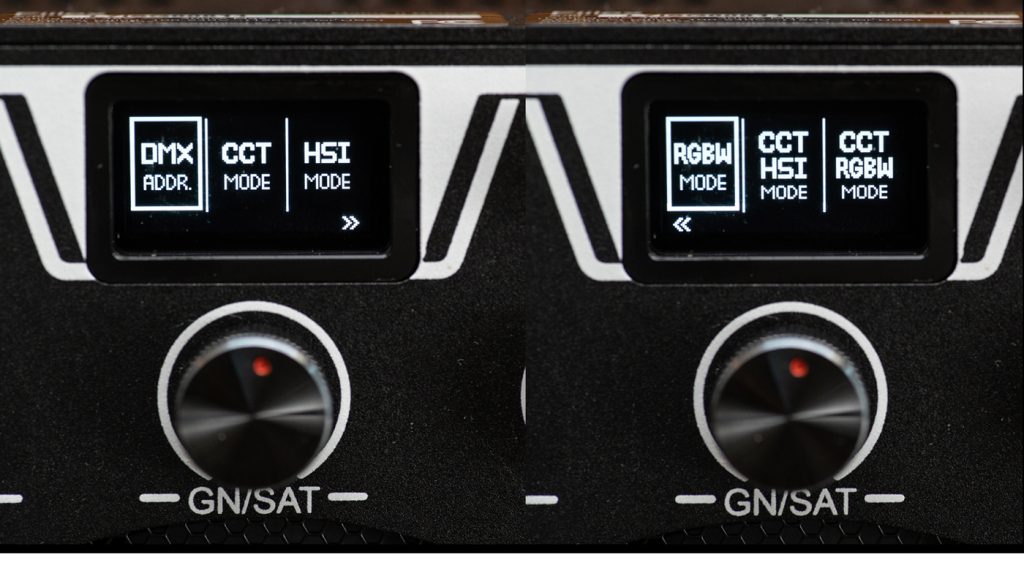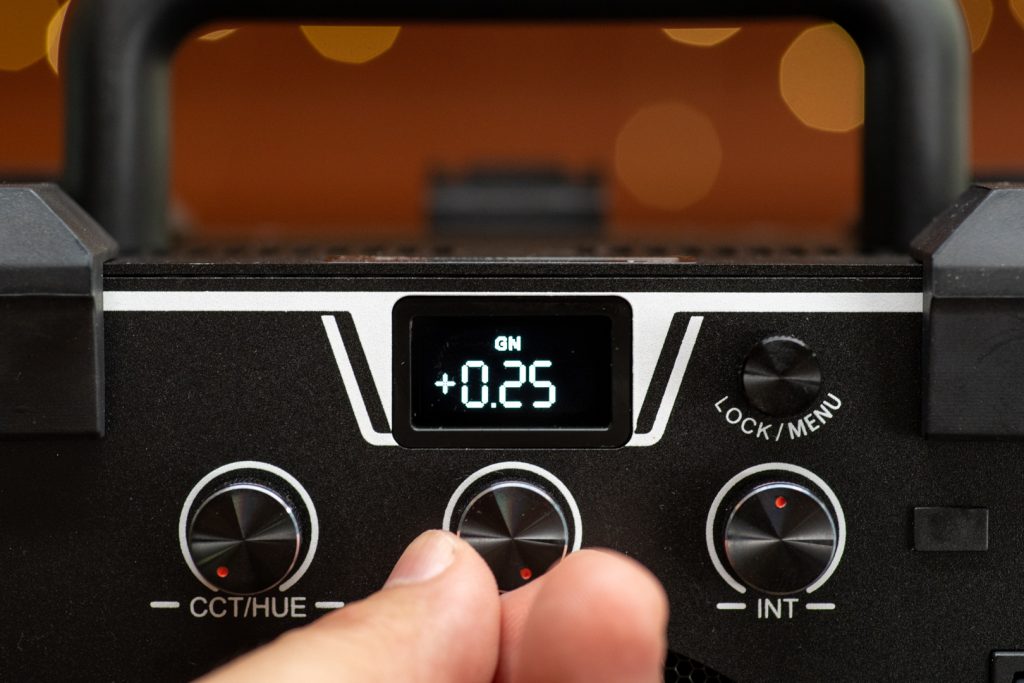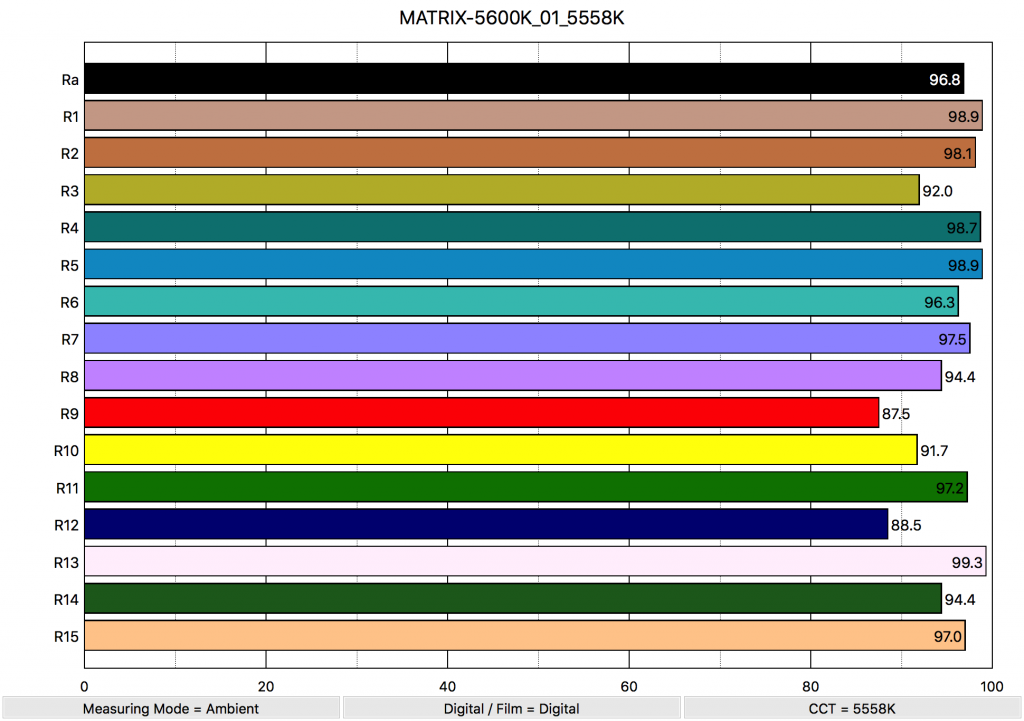Fiilex introduced the M1 LED back in 2016, in fact, we covered it at NAB. They have taken the basic design and advanced it with lots of new features like adding full-color spectrum output. The design of the Fiilex Matrix II RGBW is different from most LED fixtures that are rectangular in shape while the Matrix II RGBW is more of a square cube. The dimensions of the fixture are not a cube at L 6.7 ” x W 12.2 ” x H 16.5 ” (17 cm x 30.98 cm x 41.91 cm) but it sure looks like one. Don’t let the smaller size fool you. The Matrix II RGBW is punchy. Inside the fixture is four 75W DiCon Dense Matrix LED’s. Each array of LED’s is housed inside a lens. This helps to give a more collimated light, which equates to better output, better color mixing, and cleaner well-defined shadows.
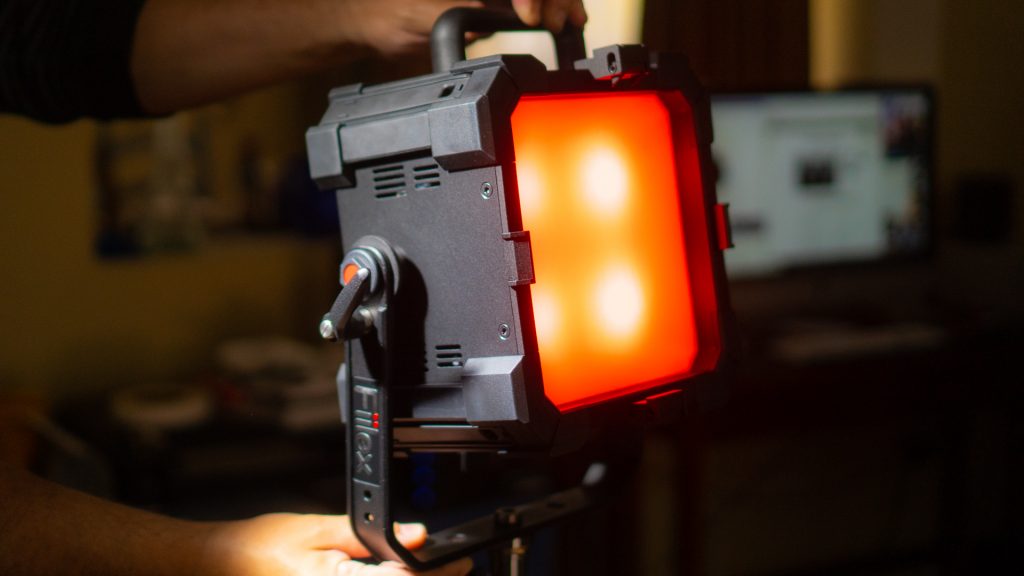
Fiilex Matrix II RGBW FEATURES
- Full RGBW control
- Custom multi-wavelength LED groups deliver rich, bright color
- Smooth dimming down to 0% without flicker
- RDM/DMX512
- 5V/1A USB powers wireless DMX
- IP-24 weather resistant
- XLR power input compatible with 48V battery power
- Unique Fresnel accessory for increased punch
- Future-proof: Ability to upgrade the firmware in the field
- Compatible with industry-standard softboxes and octabanks via speed ring accessory
- Lightweight (9.7 lbs without the ballast) vs. comparable RGB fixtures
- Extreme durability with high-grade aluminum housing and a ruggedized exterior
- Single light kit falls within standard airline checked bag weight limits
SPECIFICATIONS
| Fresnel Size | Optional Quad Fresnel Leans (Removable) |
| Beam Angle | 99° (31° w/ Optional Quad Fresnel Lens) |
| CCT Range | 2800-10000K Continuous Tuning |
| Hue Control | ±0.25 Green/Magenta |
| CRI | 95 Typical. |
| Dimming | 100% – 0% |
| LED | (Four) 75W DiCon Dense Matrix LED |
| Input Power | 120V-240VAC |
| Power Consumption | 340W Max AC | 300W Max DC |
| Power Adapter | AC Input: 100-240V AC, 50~60Hz | DC Output: 48V |
| DC Power Port | XLR-3P |
| DMX Port | Two XLR Ports-5P (512 Addresses) |
| USB 5V | Yes |
| Weight | Fixture: 9.7 lbs / 4.4kg (Includes Yoke) Power Adapter: 5.7 lbs/2.6kg |
| Size | L 6.7 ” x W 12.2 ” x H 16.5 ” L 171mm x W 311mm x H 418mm |
| Mount Type | IBaby Stud 5/8″ Female (16mm) and Junior Stud 1-1/8″ Male (28mm) |
| Thermal Design | Advanced Vapor Cooling System (Fan Cooled) |
| Operating Temperature | 32-104ºF / 0-40º C |
Weight
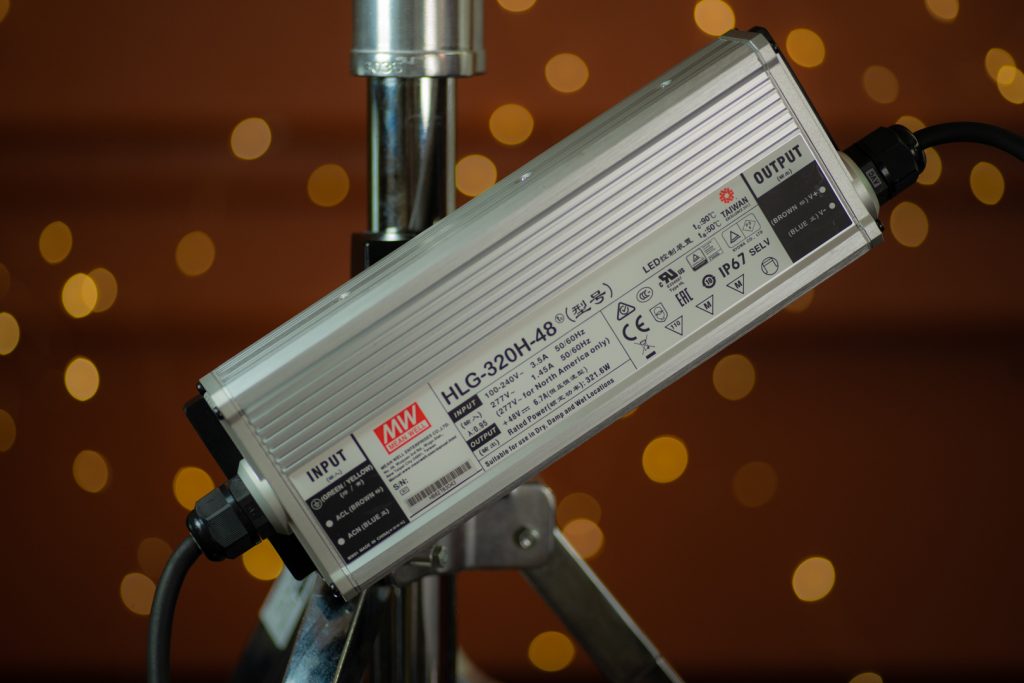
The fixture itself isn’t that heavy at 9.7 lbs (4.39 kg). The light requires a separate ballast and it also isn’t too heavy at 5.7 lbs (2.58kg). The ballast, however, has a very solid build and is fairly small and easy to work with. On the ballast, it states “Suitable for use in dry, damp and wet locations”. The AC and power cable that come off the ballast is pretty short.
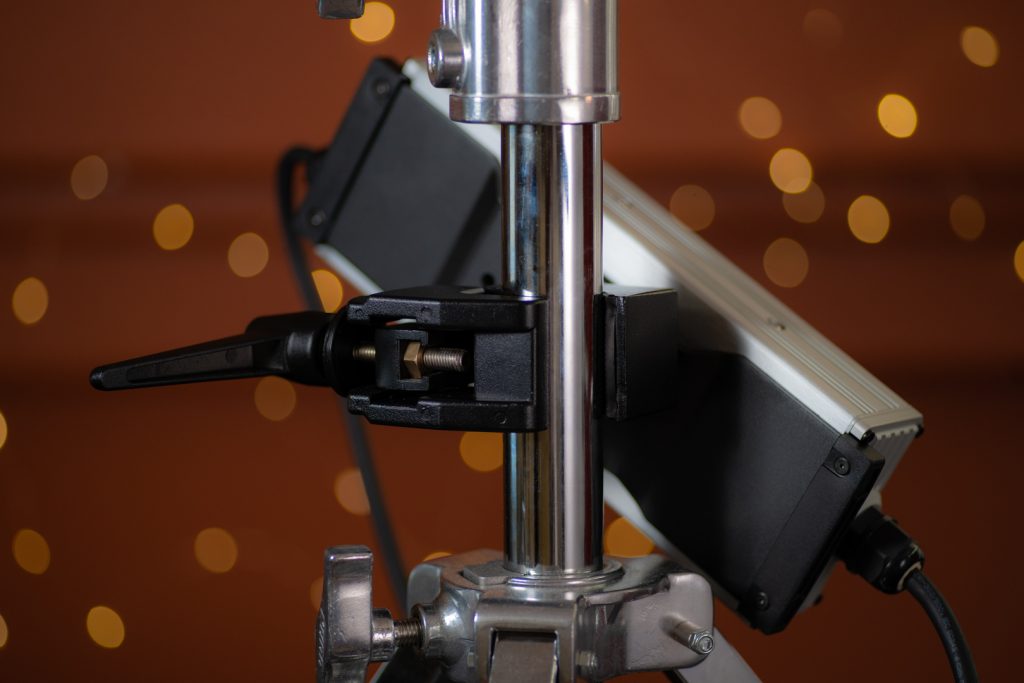
To keep it off the ground Fiilex includes a non-proprietary Mafer clamp to attach the ballast to a stand. This is good for a couple of reasons. Getting the 5.7 lbs/2.6kg ballast off the floor helps keep the clutter down, Makes moving the fixture easier and protects it from being kicked or bumped. When mounted on the lower portion of the stand it will add stability to the setup as well. I’m a big fan of getting the ballast off the floor.
Power draw
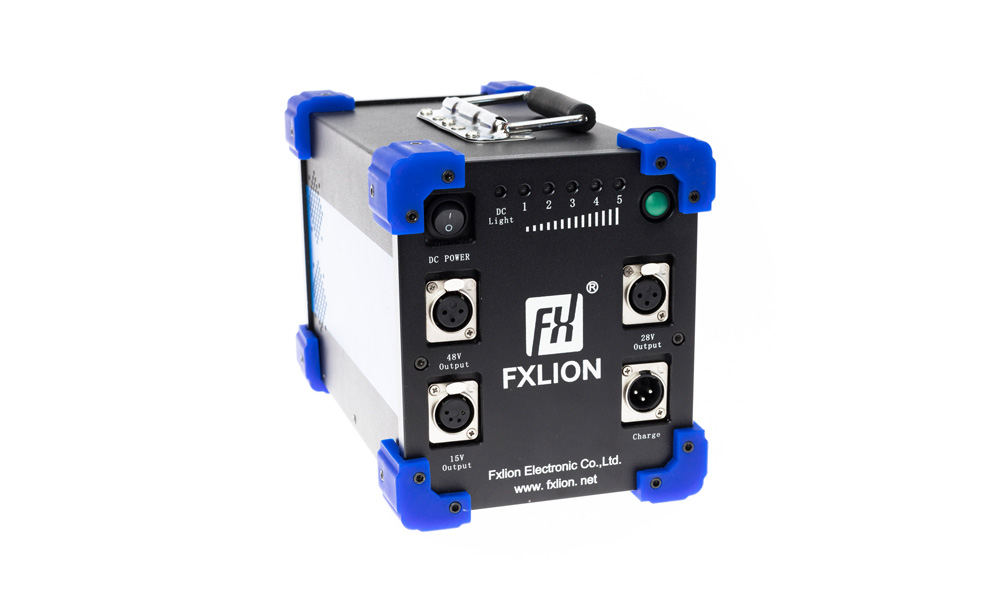
With a power draw of 340W Max AC / 300W Max DC, the Matrix II RGBW can’t be powered with a 14.8 volt Gold Mount or V-Mount style battery as it’s power requirements exceed those type of batteries. As a comparison, the Litepanels Gemini has a power draw of 325W (nominal), 350W (Max), and the ARRI SkyPanel S30-C has a power draw of 200W. Both the Litepanels and the ARRI have the ability to be run off V-lock or Anton Bauer Gold mount batteries using optional dual battery plates. This is something you can’t do with the Fiilex.
If remote use is necessary, a much larger capacity box type system will be needed. Fiilex recommends the Fxlion 48V mega battery B or similar. The voltage required for the fixture is over three times what most broadcast camera batteries offer. These type of batteries are expensive. Usually running in the high $2000 and up.
Go Softer
The light is a fairly soft source with the non-removable milky front plexi. If you want to go softer the Matrix II RGBW has built-in softbox slots. I like that you can add a softbox without a speedring, unfortunately, when I attached my small Chimera it was a little tight plus the back flaps wouldn’t close all the way so light leaks out of the back. A little gaffer tape will fix that. Once fully attached it works as it should, however, you can’t rotate the softbox since it’s mount doesn’t spin. 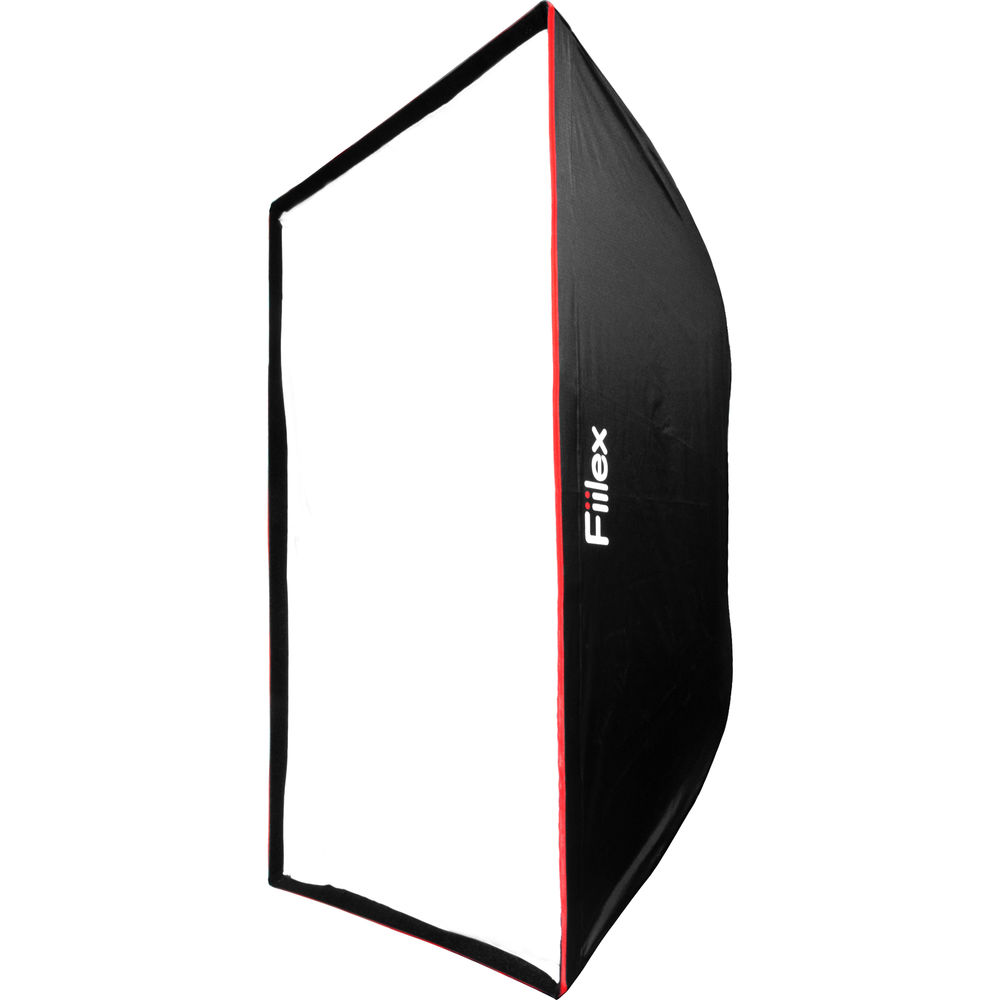
Fiilex offers an affordable Matrix Softbox (36 x 48″) that cost $195 and also works without a speedring. I haven’t tested it for fit. A disadvantage of not using the optional Fiilex speedring ($250 USD) is again you can’t spin the softbox from vertical to horizontal. I do think the optional speedring is worth the investment if you’re going to use a softbox often. It also allows for very quick removal with the well-designed accessories attachment system on the front of the light. The clips are spring loaded and lock accessories in like a barn door or speed ring.
Accessories
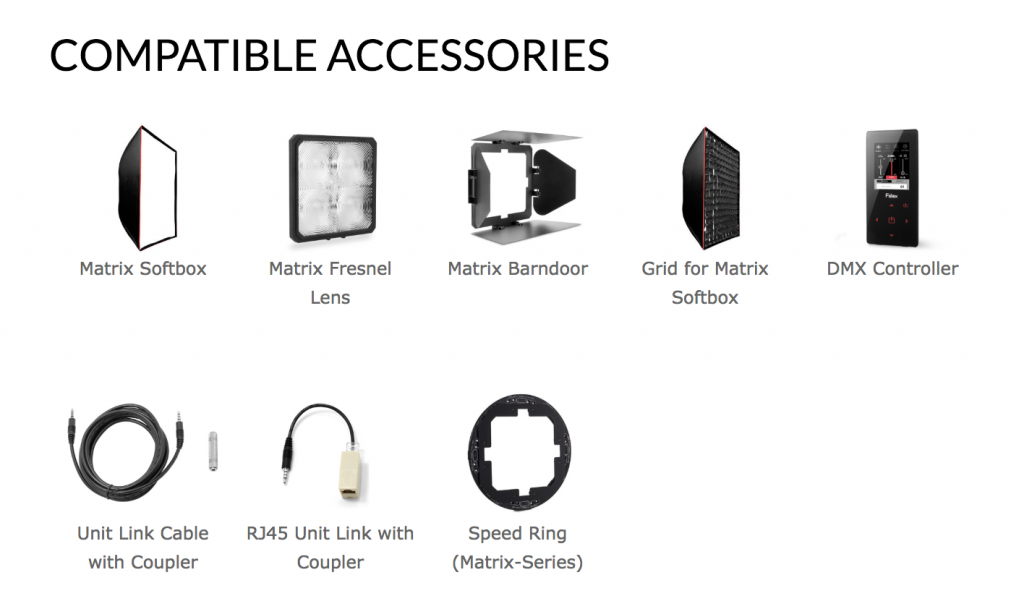
The basic light doesn’t come with many extras however Fiilex has several offerings to make the fixture more versatile and easy to use. I do wish an app was available to control the single fixture, however, no Bluetooth or wireless connectivity is available on the light.
- Softbox
- Fresnel Lens
- Barndoor
- Grid for softbox
- DMX Controller
- Unit Link Cable with Coupler
- RJ45 Unit Link With Coupler
- Speed Ring for Matrix Series
Keeping it cool
With the brightness levels of LED lights growing so has the internal temperatures they create. RGBW lights also generate far more heat than regular LEDs. To keep them cool a fan and or heatsink are required. On the back of the Matrix II RGBW is a 5″ fan that does just that. This fan is dead quiet and will not interfere with audio capture on set. It’s very impressive. I’ve run the fixture for long periods of time and it never ramped up. Merely stayed on at a consistent speed.
Build Quality
If you need a fixture that can take some abuse the Matrix II RGBW should be on the list. The all-metal housing is surrounded with rubber bumpers on all corners front and back to soften the impact on those vulnerable edges if the light falls over. To illustrate this Fillex did some testing at the factory.
From the looks of the test it survived but a little dishevelled 🙂
While the body of the Matrix II RGBW is solid so is the rest of the parts. For example the yolk. It’s very firm with no flex or wobble to be found. Likewise is the stand mount that uses a Junior Pin / Baby Receiver. It’s chrome plated and built to last.
The 9.7 lb fixture is held in place with a single all metal yolk knob. When loosened the fixture will release freely from the rubber washers that hold it in place and when tightened the hold is strong. The Matrix II RGBW has an impressive build quality that looks like it will last for some time with frequent use. I see it as a prime candidate for rental house’s
Controls
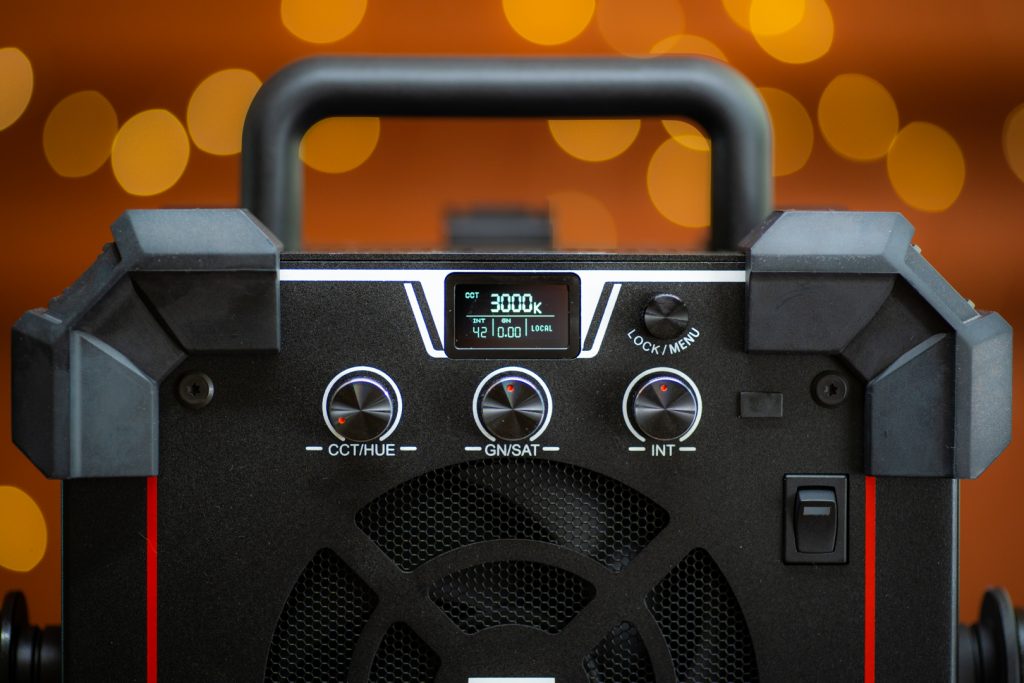
The controls are all on the top back portion of the Matrix II RGBW. Once the fixture is supplied power, the menu system can be changed even while the light is turned off. The fixture has a minimalist approach to the menu system. At first, I couldn’t figure out how to get into the menu. To prevent accidental setting changes a simple quick double tap of the LOCK/MENU dial gains access to the menu settings.
Once inside you have 2 pages with six options however if no DMX unit is used then only three are accessible. From the far left or page-1 is the DMX ADDR. setting for assigning the fixture a specific DMX address number for use with DMX control.
CCT MODE – To put the Matrix II RGBW in color temperature mode double tap the LOCK/MENU and select CCT MODE. Change the color temperature with the CCT/HUE dial for color temperatures from 2800K to 10,000K.
A nice feature is the ability to adjust with the GN/SAT (Green / Saturation) dial ±0.25 Green/Magenta for color spikes. If the light is being used with other fixtures that may have a color spike you can simply adjust for it by dialling in the shift. You will need a color meter to get proper readings for color spikes. Hence a Sekonic C700-U Spectromaster would do the job perfectly as it gives you the amount of ± Green present in the reading.
HSI MODE puts the Matrix II RGBW in full-color spectrum mode. To change the color, the CCT/HUE dial goes through the color spectrum in degrees from 0° to 360°. The GN/SAT is for changing the saturation and the INT dial (Intensity Control Knob) adjusts the brightness or output. Once you get used to the menu it’s very simple to control the fixture. I did notice the dials are very sensitive and move very quickly through the ranges. It’s a little tough to nail 5600K exactly on the first pass.
Output and Color
Accurate white light from LED’s keep getting better and so has output. The Fiilex Matrix II RGBW performs well in both categories. Below are test results for output and Kelvin.
Real World Lighting
See how the Fiilex Matrix II performs in the real world, mixed with other lights.
How bright is the Matrix II RGBW?
Here comes the geeky stuff! I set the fixture 1-meter away and took readings from the center of the light with the Sekonic C-700-U color meter.
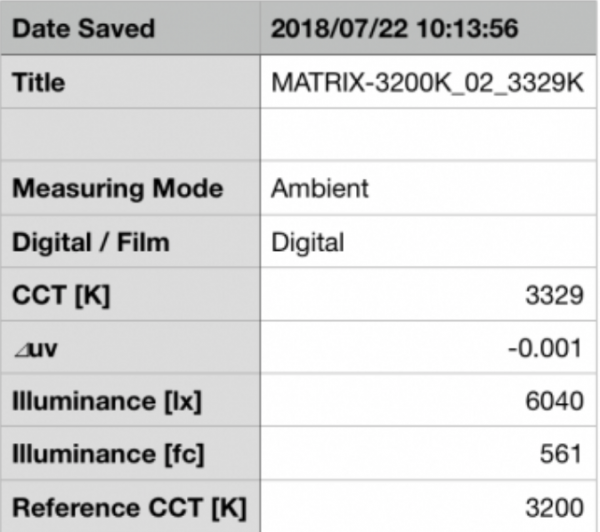
Fiilex claims that the Matrix II RGBW can produce 6665 Lux when set at 3200K at a distance of 1m. From my testing, I found that the light only outputs 6040 Lux, which was 9.3% less than the quoted figures from Fiilex.
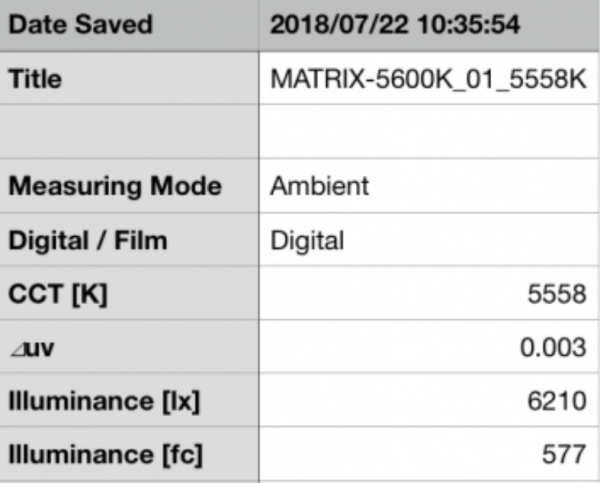
When used at 5600K, Fiilex claims that the Matrix II RGBW can produce 6760 Lux at a distance of 1m. From my testing, I found that the light only outputs 6210 Lux, which was 8.1% less than the quoted figures from Fiilex.
Readings
- 5600K – 6210 Lux
- 3200K – 6040 Lux
For reference here are a few other fixtures output.
- Fillex Matrix II RGBW 5600K 6210 Lux ($2995)
- Litepanels Gemini 9970 Lux $(4298)
- Digital Sputnik DS 1 LED 20° beam angle fixture 32,000 Lux ($2500)
- ARRI SkyPanel S30-C LED Softlight 110° Beam Spread 4697 Lux ($4113)
The Matrix II RGBW is in an interesting place in the RGB LED lighting world. We have a few expensive models like the ARRI Skypanels and Cineo Standard 410 but not a lot of mid-priced options with quality builds. Now, we are seeing a lot of pre-releases coming out soon and by IBC you can bet several lower budget friendly fixtures such as the LUPO Superpanel Full Color 30 and Luxli Timpani 1×1 RGBAW will start shipping. I do want to stress the Matrix II RGBW build and overall quality is very high and should be compared with caution to lower-priced fixtures with much less build quality. The good thing is we have a lot of options these days in LED lighting and with RGB more options are also starting to happen.
HSI Mode
At this time the Matrix II RGBW fixture doesn’t have any FX lighting modes like party lights, strobing or emergency vehicle effects, however, Fiilex is going to include them by the end of 2018. To add effects and updates it’s a simple firmware update through the USB port.
Below is a graph that shows the color wheel in degrees. This will give you a better understanding of the values and where they land in between. All readings are done at full saturation.
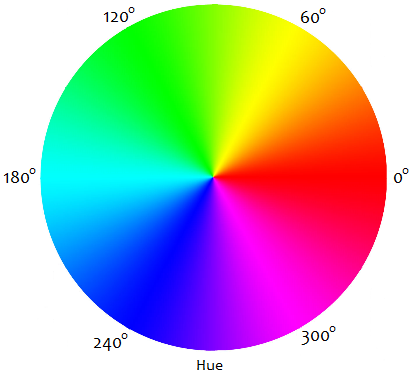
- 0° – 1610 Lux
- 60° – 3159 Lux
- 120° – 2720 Lux
- 180° – 2760 Lux
- 240° – 1250 Lux
- 300° – 1970 Lux
- 360° – 1610 Lux
Color Redering at 3200K
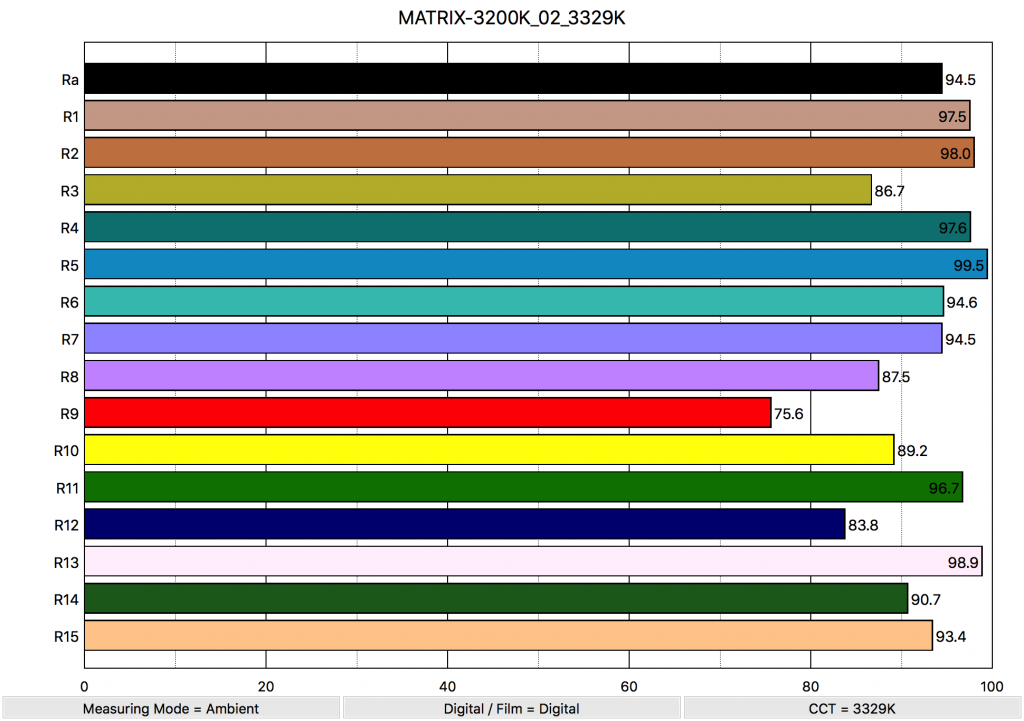
At 3200 K the light had a CRI (R1-R8) of 94.5 with an Extended CRI (R1-R15) of 92.28. These are pretty good scores. The scores for R13 (closest to caucasian skin tones) was 98.9, and the score for R15 (closest to Asian skin tones) was 93.4. These were excellent results. The only negative aspect of the scores was that the light only managed to score 75.6 for R9 (Red).
Fiilex quotes an Extended CRI (R1-R15) of 95 when the light is set at 3200 K. I found it to be a little below those numbers.
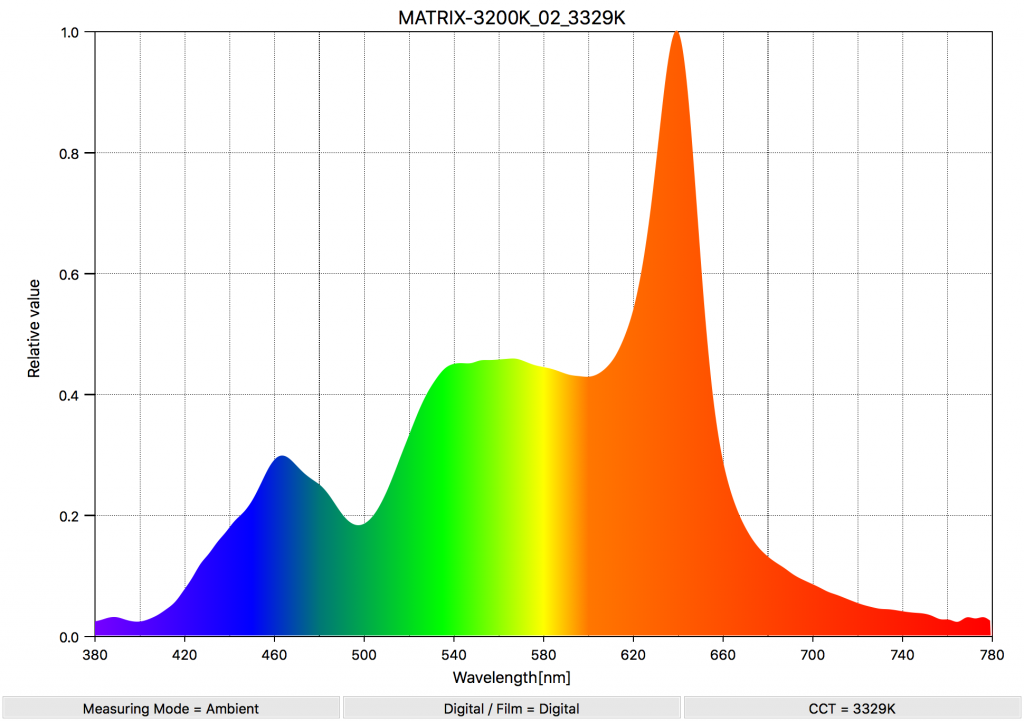
CRI scores are one thing, but how is the lights spectral distribution? Above you can see the spectral distribution of the Fiilex Matrix II RGBW when set at 3200 K. There are quite a lot of gaps in the spectrum and the spectrum is not very full. Which is telling me the light is failing to produce a lot of the required colors to produce a good quality 3200K source.
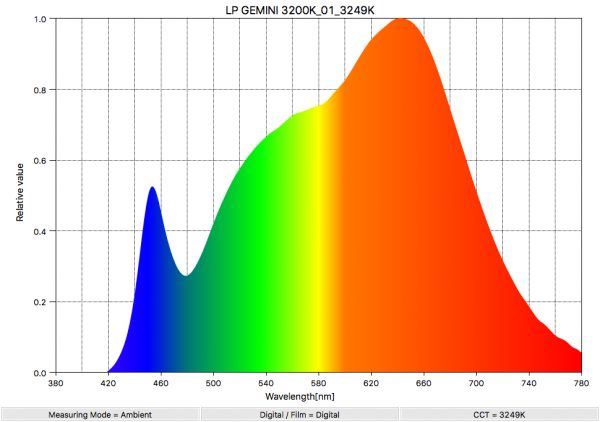
As a comparison, above you can see what the spectral response was for the Litepnales Gemini when it is used at 3200 K.
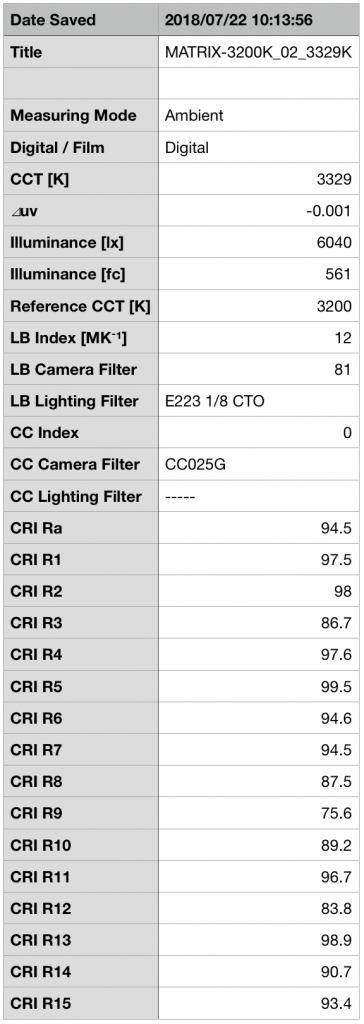
In the text readout, you can see the CC Lighting Filter category shows no green or magenta adjustments are required.
Color Rendering at 5600K
At 5600K the light recorded a CRI (R1-R8) of 96, and an Extended CRI of 95.33. These are very good scores. Again the R9 Red is a bit low at 87.5, however, that is better than the 75.6 it scored at 3200K. The scores for R13 (closest to caucasian skin tones) was 99.3, and the score for R15 (closest to Asian skin tones) was 97.0. These were excellent results.
Fiilex quotes an Extended CRI (R1-R15) of 94 when the light is set at 5600 K.From my testing the light actually scored better at 5600 K than the claimed figures.
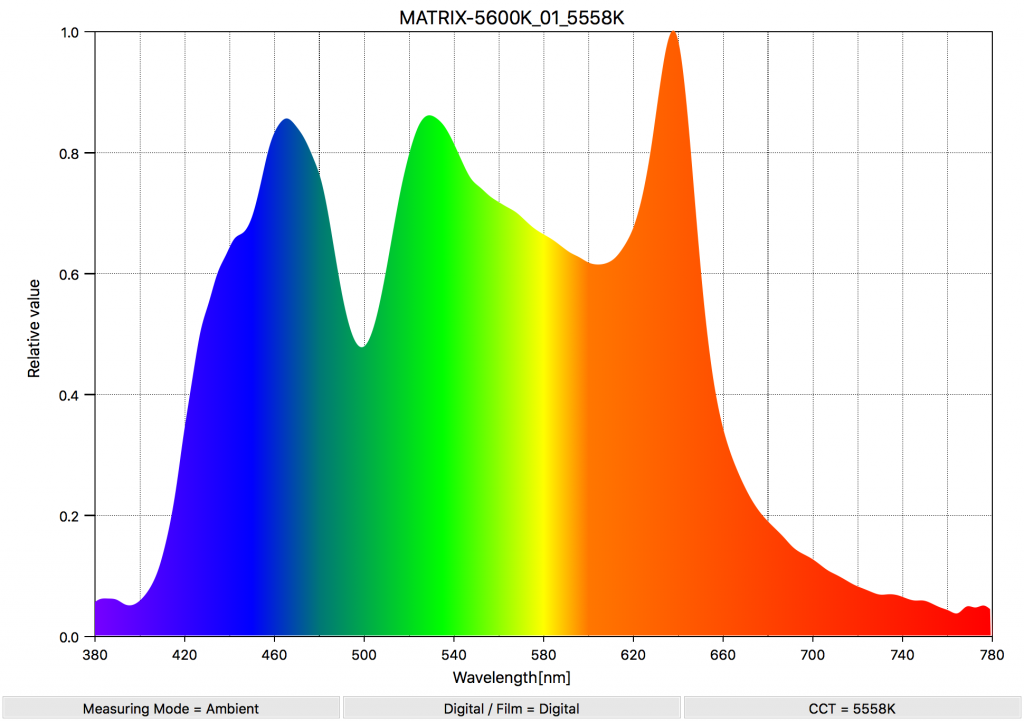
Above you can see the spectral distribution of the Fiilex Matrix II RGBW when set at 5600 K. This result was far better than when using the light at 3200 K. There still are quite a lot of gaps in the spectrum, but the spectrum is a lot fuller. The Fiilex Matrix II RGBW can certainly produce a ton of color information in the spectrum and to see a large number of wavelengths score above 0.6 is very impressive.
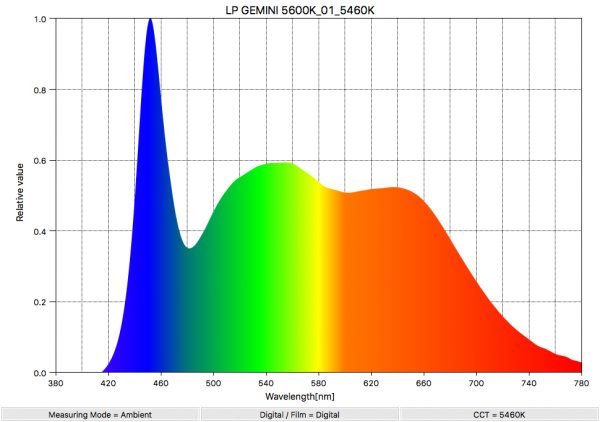
As a comparison, above you can see what the spectral response was for the Litepnales Gemini when it is used at 5600K. While the Gemini’s spectral response is a lot more linear it doesn’t produce nearly as much color information as the Fiilex.
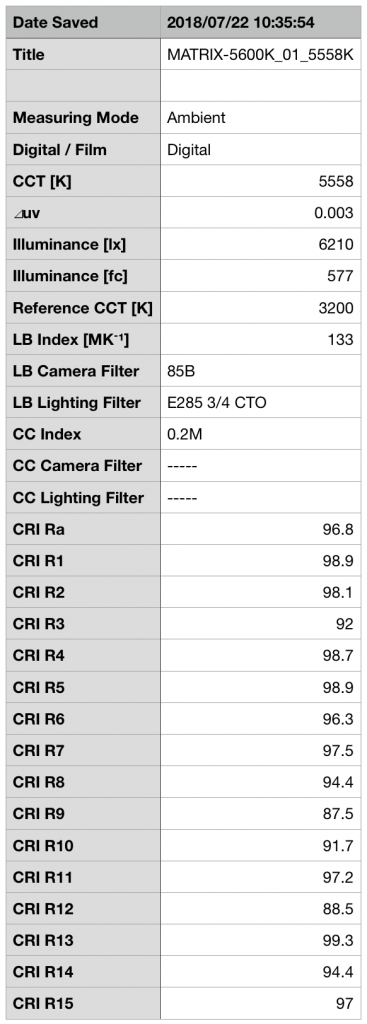
At 5600K the light only exhibits a slight very slight push towards magenta with a CC Index score of 0.2M. This is very good news for the Matrix II RGBW as color spikes make mix & matching fixtures on set a real pain in the butt. Now if those other fixtures have color spikes the Matrix II RGBW can join it by simply dialling in plus or minus green. Did I mention how much I like that?
The output is fairly close with daylight 5600K having a tad more at 6210 Lux than the 6040 Lux it outputs at 3200K. Also worth mentioning is the actual Kelvin settings are very accurate. I’ve tested some fixtures that had a much larger discrepancy like 5600K actually reading closer to 6000K and higher.
Beam angle
The beam angle on the Matrix II RGBW is very wide at 99° (31° w/ Optional Quad Fresnel Lens) this gives a lot of coverage, especially when using the RGB modes. Very easy to splash a lot of color into the background.
Competition
- Litepanels Gemini 93° beam angle 9970 Lux $(4298)
- Digital Sputnik DS 1 LED 20° beam angle fixture 32,000 Lux ($2500)
- ARRI SkyPanel S30-C LED Softlight 110° Beam Spread 4697 Lux ($4113)
The Fiilex Matrix II RGBW’s direct competition comes in the form of the Litepanels Gemini, Digital Sputnik DS 1 LED, and ARRI SkyPanel S30-C. While the Fiilex is cheaper than the Litepanels and the ARRI offerings it also doesn’t have built-in filters and special effects modes, however, these are coming in a simple firmware update by the end of the year.
Compared to the Gemini that weighs in at 10.1kg (22.2lb), and the ARRI SkyPanel S30-C (also 10.1kg with ballast), the Matrix II RGBW fixture weighs in at 6.97 kg (with the ballast). The compact size of the Fiilex Matrix II RGBW is what really sets it apart from the ARRI and the Litepanels.
Final thoughts
I like the Matrix II RGBW. I know many will feel it’s out of their price range at $2,495 US, however, I think it fits in a unique place considering it’s build quality, tech, and very handy 99° beam angle. If it is out of your price range than new affordable RGB solutions are now coming to the market such as the Lupo Superpanels Full Color 30 and Luxli Timpani 1×1 RGBAW.

Splashing color on a background is so easy and those colors are nice and saturated if you want them to be. Wide and colorful. Nice combo! I do wish I had the fresnel and speedring to test as I tend to prefer soft light and it would have been nice to see the softbox Fillex has for it. The Fresnel also looks like an interesting design. The output is good at 6210 lux from 1-meter. I did find it to be a little less than I would desire behind a 4×4 diffusion.
All in all, I think Fiilex have come up with a really nice light that is well built, well designed and has a decent output. It’s compact size and form factor makes it a good alternative to the more expensive Litepanels Gemini or ARRI SkyPanel S30-C.


